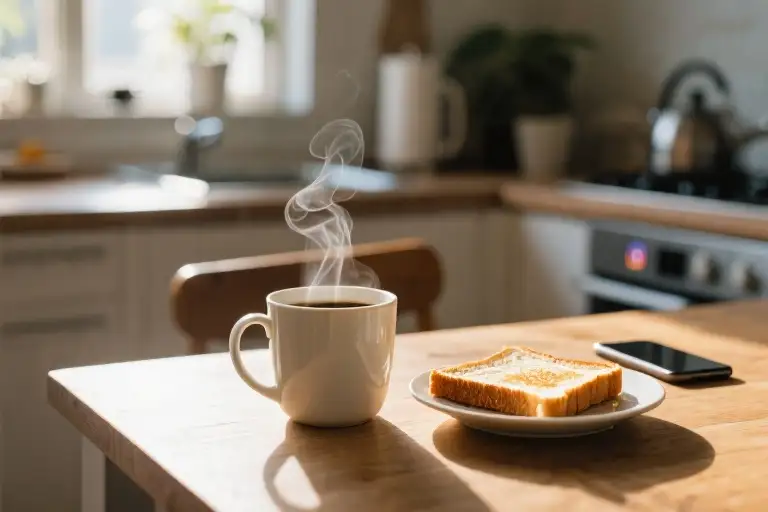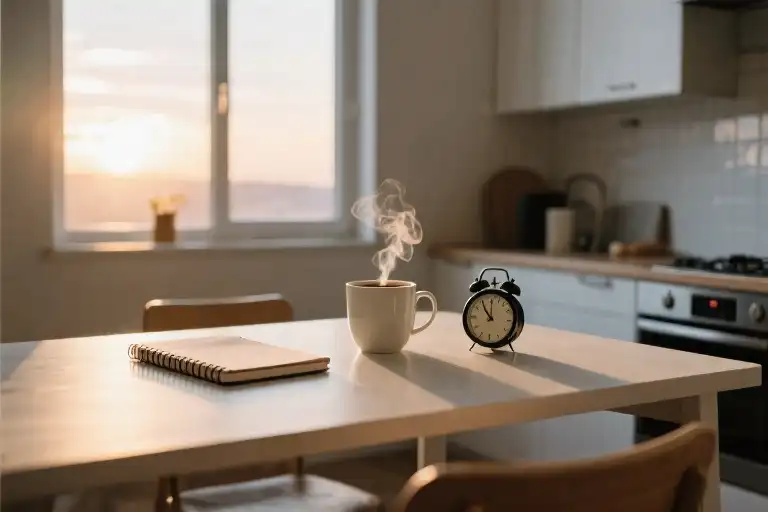The morning light slants across your kitchen counter as you carefully arrange the avocado toast – adjusting the sesame seeds, finding the perfect angle. Your thumb hovers over the shutter button. But pause for a second: Are you capturing this moment for yourself, or curating content for invisible jurors?
Scrolling through #RomanticizeMarch reveals thousands of nearly identical scenes: steaming mugs held against sweater sleeves, rain-streaked windows with open journals, slow-motion walks through farmer’s markets. This compulsive aestheticization of everyday life has become our generation’s peculiar liturgy. What began as well-intentioned self-care – finding joy in life’s intermissions – has morphed into a relentless performance where we’re both actors and audience in our own Truman Shows.
The irony stings deeper when we realize our quest for authenticity has birthed new anxieties. That coffee you painstakingly staged? It’s cold by the time you taste it. The ‘spontaneous’ picnic required three outfit changes and 27 takes. We’ve created a paradox where romanticizing life – originally meant to alleviate stress – now generates its own peculiar strain of performative exhaustion. As the like notifications pour in, we’re left wondering: When did living become synonymous with broadcasting?
This cultural shift didn’t happen overnight. Post-war generations found solace in small rituals – the deliberate preparation of afternoon tea, the mindful folding of laundry. These were private acts of resistance against life’s chaos. But social media platforms transformed personal mindfulness into public spectacle. The algorithm rewards not authenticity, but aesthetic conformity; not genuine emotion, but emotionally coded visuals. Your grandmother’s handwritten recipe cards brought her quiet joy, but your #HomeBaking post needs perfect crust shots and a trending audio track to ‘count.’
Main character energy, that intoxicating cultural narcotic, promises empowerment but often delivers isolation. By scripting our lives like indie films, we risk missing the unphotogenic magic between scenes – the unposed laughter that wrinkles noses, the messy countertops where real conversations happen. Perhaps true romance lies not in performing life, but in occasionally stepping off-stage to experience it unmediated.
So tomorrow morning, try this radical act: Drink your coffee while it’s hot. Let the toast crumbs fall where they may. Notice how the warmth stays in your hands longer when you’re not reaching for your phone. Some moments gain their value precisely because they’re yours alone – unoptimized, unshared, unromanticized in the most beautiful way.
The Poetry of Survival: Origins of Romanticization
We’ve all had those mornings – the kind where sunlight slants through the blinds just right, catching the steam rising from your coffee in golden swirls. Before smartphones existed, you might have simply sighed and thought what a lovely moment. Today, that same sigh gets interrupted by an almost reflexive urge: This would make a great Instagram story.
This shift from private appreciation to public performance didn’t happen overnight. The roots of romanticizing daily life stretch back to postwar Europe, where shell-shocked civilians rebuilt sanity through ritual. My Italian grandmother, who survived Mussolini’s regime, measured stability in coffee grounds – the daily act of tamping down fresh beans became her anchor. “When the world outside was chaos,” she’d say while polishing her moka pot, “this little metal tower was something I could control.”
Psychologists call this existential micromanagement – our tendency to grasp at small controllable pleasures when larger systems feel unmanageable. The 1950s housewife arranging perfect place settings. The 1970s office worker savoring a precisely timed cigarette break. These weren’t just habits; they were psychological lifelines, ways to assert I exist when the universe seemed indifferent.
Then came the digital camera revolution in the early 2000s, quietly altering how we relate to these moments. Where my grandmother’s coffee ritual lived solely in her senses (the bitter aroma, the hissing percussion), ours now exist simultaneously as experiences and potential content. The pivotal change? When documenting became as instinctive as experiencing. I noticed it first with my niece – at eight years old, she’d pause mid-bite of birthday cake to demand “Wait! Let me get a good angle!”
This technological shift created what anthropologists term the dual consciousness of digital natives: we now navigate life both as participants and potential directors of our own documentaries. The morning coffee isn’t just warm liquid in a cup; it’s a prop in the ongoing film we’re all unconsciously casting, shooting and editing about ourselves.
Yet beneath this performative layer, the original survival mechanism still pulses. When we zoom in on dewdrops clinging to a spiderweb or film our hands kneading bread dough, we’re replicating our grandparents’ need to say I am here, this matters – just with hashtags added. The tragedy isn’t that we romanticize life, but that we’ve outsourced the validation of those moments to invisible audiences.
Perhaps this explains why #RomanticizeYourLife videos often feel equal parts soothing and unsettling. Watching someone slowly stir honey into tea satisfies our craving for controlled beauty, while the perfectly framed shot reminds us we’re consuming a curated reality. The same platforms that taught us to aestheticize existence now make it nearly impossible to experience anything without imagining its content potential.
But here’s the secret our grandparents knew: true romanticization never requires witnesses. My grandmother’s coffee tasted no less significant because no one photographed it. The challenge for our generation isn’t abandoning life’s small poetry, but relearning how to savor it offline – to occasionally let beautiful moments dissolve like sugar in hot liquid, leaving no trace beyond memory’s warmth.
When Life Becomes a Film Set
Scrolling through Instagram’s sunrise-lit breakfast posts or TikTok’s perfectly choreographed #MorningRoutine videos, have you ever wondered when our private moments became public performances? The statistics speak volumes: 72% of breakfast photos uploaded daily on Instagram undergo some form of filtering, while lifestyle hashtags like #ThatGirl accumulate billions of views by selling an impossible standard of aesthetic living. What began as personal documentation has evolved into a relentless audition where we’re both the actor and the audience in our own reality show.
The Pressure of Performative Perfection
Take the fitness industry as a case study. What used to be about celebrating movement has morphed into a sartorial spectacle. Fitness influencers don’t just demonstrate workouts—they showcase coordinated Lululemon sets, designer water bottles, and salon-fresh ponytails that bounce in slow motion. A 2023 survey revealed that 68% of gym-goers under 30 feel compelled to upgrade their workout wardrobe before posting exercise content, even when financially strained. This phenomenon creates what psychologists call ‘visual debt’—the exhausting gap between how we live and how we present our lives.
Platform algorithms act as invisible directors in this production. They reward certain aesthetics through features like Instagram’s ‘Top Posts’ or TikTok’s ‘For You Page’ curation. Notice how certain visual elements—steaming matcha in ceramic bowls, open planners with calligraphy headings, golden hour silhouettes—appear with eerie consistency across accounts? This isn’t organic behavior; it’s algorithmic conditioning. When platforms prioritize ‘high aesthetic value’ content (translation: photos that keep users scrolling), they effectively draft a style guide for modern existence.
The Algorithmic Choreography
Behind every ‘spontaneous’ morning routine video lies calculated optimization. Content creators have decoded the platform’s preference for:
- Vertical video formats that dominate mobile screens
- ASMR sound design (think pouring coffee, pen scratching paper)
- Color-graded mundanity where even folding laundry becomes cinematic
This creates a vicious cycle: users emulate trending aesthetics to gain visibility → algorithms amplify similar content → entire communities adopt homogenized lifestyles. The result? We’ve developed what sociologists term ‘performative muscle memory’—automatically adjusting our real-life actions for their digital appeal. That artfully messy bun you toss up before grocery shopping? It’s less about convenience and more about maintaining your ‘brand’ of relatable imperfection.
Reclaiming Your Backstage
Breaking free requires conscious effort. Start by identifying your ‘performance tells’—those small adjustments you make when the camera comes out. Maybe you rearrange pillows before reading or wait for sunlight to eat avocado toast. These aren’t inherently bad, but when they become prerequisites for enjoyment, we’ve crossed into dangerous territory.
Try this digital detox exercise: For one week, capture moments exclusively through memory, not your camera roll. Notice how your brain starts framing experiences differently when not preoccupied with shareability. You might discover that unphotographed sunsets feel more vivid when your eyes aren’t constantly checking a screen’s color accuracy.
Remember: Life isn’t a continuous take. The most authentic moments often happen between scenes—when the metaphorical camera stops rolling, and we simply exist without an audience. As the curtain falls on performative living, what remains is the quiet joy of experiences that are beautiful precisely because they’re unrecorded.
The Authenticity Diagnostic: Why Do We Really Romanticize Our Lives?
Let’s start with a simple experiment. Think about the last time you paused to admire something ordinary – steam rising from your morning coffee, sunlight hitting your bedroom wall at a particular angle, the sound of rain against your window. Now ask yourself: Did I feel the urge to document this moment? More crucially: Who was this moment really for?
The Motivation Behind the Filter
We’ve all been there. That perfect cappuccino art that needs to be Instagrammed. The carefully arranged work-from-home setup that just happens to frame your face in golden hour lighting. The ‘casual’ stroll through the farmer’s market that somehow becomes a TikTok montage. These aren’t inherently bad behaviors – but when we examine them closely, they reveal fascinating truths about our relationship with authenticity.
Take this quick self-assessment:
- When you prepare your morning coffee:
- [ ] You instinctively reach for your phone to capture the ‘perfect’ moment
- [ ] You enjoy the ritual regardless of whether it’s documented
- [ ] You sometimes do both, depending on your mood
- Your ideal weekend activity:
- [ ] Something photogenic enough to post about
- [ ] Something genuinely relaxing, regardless of how it looks
- [ ] You don’t think about this distinction at all
- When something beautiful happens unexpectedly:
- [ ] Your first thought is ‘I wish I’d recorded that!’
- [ ] You’re glad no one else saw it
- [ ] You briefly consider recreating it for content
There are no right or wrong answers here – just awareness. What we’re really measuring is the intention behind our ‘romanticized’ moments. Are we experiencing them, or are we producing them?
The Unrecorded Happiness Archive
Here’s a challenge: can you recall a recent beautiful moment that wasn’t captured or shared? Maybe it was:
- The way your cat stretched in a patch of sunlight when no one was watching
- That perfect bite of food you didn’t photograph because you were too hungry
- A stranger’s unexpected kindness that happened too quickly to record
These moments represent something precious – experiences that existed purely for their own sake, not as content waiting to happen. They’re the antidote to performative romanticizing.
Reader Interaction: Share in the comments below – what’s one unphotographed moment that stayed with you recently? Let’s create an archive of authentic, uncurated joy.
The Spectrum of Romanticization
Not all romanticizing is created equal. There’s a spectrum:
| Healthy Romanticizing | Performative Romanticizing |
|---|---|
| Making tea mindfully because you enjoy the ritual | Making tea primarily to post your ‘aesthetic’ setup |
| Going for a walk to clear your head | Going for a walk to get the perfect golden hour selfie |
| Keeping a gratitude journal privately | Posting daily gratitude lists for engagement |
The difference lies in where your attention goes – are you focused on the experience itself, or its potential as shareable content?
The Main Character Paradox
Here’s the ironic truth about ‘main character energy’: when we’re too busy performing our lives, we actually become less present as the main character of our own experience. That carefully curated coffee date with yourself? If you spent half of it adjusting angles and filters, how much of it did you truly live?
This isn’t about shaming documentation – it’s about noticing when the performance overtakes the pleasure. As you go about your day today, try this simple check-in: Would I still find this moment special if no one else ever knew about it?
The answer might surprise you.
The Anti-Performance Survival Guide
We’ve all been there – carefully arranging that avocado toast just so, waiting for the golden hour light to hit at the perfect angle before snapping the 27th take. What started as capturing a nice moment has somehow turned into a part-time job of curating our lives. If you’re feeling exhausted from constantly performing your own existence, here are three concrete ways to reclaim authenticity in the age of romanticized living.
1. Embrace the Blurry Sunset
Try this radical act: next time you see something beautiful – whether it’s steam rising from your morning coffee or golden leaves swirling in the wind – take out your phone and deliberately capture it imperfectly. Let your fingers shake slightly. Don’t adjust the framing. Post that slightly blurry photo without editing.
This isn’t about rejecting beauty, but about rediscovering the freedom that comes before we learned to see everything through the lens of ‘content potential.’ That blurry sunset photo might actually capture how the moment felt – fleeting, slightly overwhelming, beautifully imperfect.
2. The 30-Minute Digital Sunset
Designate the first 30 minutes after waking and last 30 minutes before sleep as sacred, device-free zones. No documenting your artfully messy bedhead. No filming your nighttime skincare routine. These small pockets of unobserved living become revolutionary acts in our always-on culture.
During this time:
- Drink your tea while it’s actually hot
- Let thoughts come and go without turning them into tweets
- Experience small joys without the pressure to ‘share the vibe’
You’ll likely discover that moments feel different – more spacious, more yours – when they’re not immediately funneled through the performative filter of ‘how will this look?’
3. Wabi-Sabi for the Digital Age
The Japanese concept of wabi-sabi celebrates beauty in imperfection and transience. Apply this to your digital life:
- Keep a ‘ugly but happy’ photo album of genuinely meaningful but unphotogenic moments
- Notice how afternoon light falls across an unmade bed without feeling compelled to ‘fix’ the scene
- Appreciate the quiet dignity of ordinary objects that don’t make it to your feed
This isn’t about rejecting aesthetics, but expanding our definition of what deserves attention. The coffee stain on your favorite book’s pages tells its own story. The worn-out sneakers that carried you through hard days have their own quiet beauty.
The Freedom in Letting Go
Here’s the paradoxical truth: when we stop trying so hard to romanticize every moment, we often find more genuine magic in the unforced, uncurated bits of life. That morning when you forgot to take a picture of your breakfast but remember exactly how the honey tasted drizzled over yogurt? That’s the real thing.
As you experiment with these practices, you might notice something surprising – the less you perform your life, the more you actually experience it. And in a world that constantly asks us to package our existence for consumption, that’s perhaps the most radical form of self-care.
The Quiet Rebellion of Cold Coffee
The coffee sits forgotten on your desk, its surface no longer graced by artful swirls of steam. The golden hour light you’d normally rush to capture has shifted to something more ordinary—just afternoon sun cutting through half-drawn blinds. You take a sip, surprised. It’s lukewarm now, but somehow richer. Without the performance of savoring, without the pressure to immortalize this moment, the flavor simply exists for you alone.
This is the paradox we’ve been circling around: that in our quest to romanticize every sunrise and seasonal transition, we’ve lost the ability to let experiences be unremarkable yet deeply ours. The #RomanticizeMarch movement, like its predecessors, promised to help us fall in love with our lives. But love, real love, doesn’t require an audience or a perfectly curated soundtrack.
The Performance Trap
We’ve internalized the idea that joy must be performative to count. That morning walk only ‘happened’ if it was tracked and shared. The flowers on our kitchen table demand documentation before we allow ourselves to appreciate them. This constant self-spectatorship creates what psychologists call the ‘observer effect’—we stop living our experiences and start watching ourselves have them through an imagined viewer’s eyes.
Platforms reward this behavior with validation loops: the more our lives resemble lifestyle content, the more engagement we receive. But beneath the pastel filters, a quiet exhaustion builds. The very act meant to help us appreciate life—romanticizing it—has become another form of labor. We’re no longer participants in our own existence; we’re unpaid art directors of a personal brand no one signed up to manage.
Three Unphotographed Moments
Try this reclamation exercise:
- The Commute You Didn’t Post: Tomorrow, notice something beautiful during your journey—the way shadows ladder across subway seats, how rain blurs neon signs into watercolor smudges. Let it exist only in your memory.
- The Meal Without a Camera: Eat something wonderful without arranging it for optimal lighting. Taste it slowly, not for a caption, but for the private pleasure of texture and warmth.
- The Conversation Kept Offline: Share a real laugh with a friend, the kind that wrinkles your nose and makes your stomach hurt. Don’t reach for your phone to memorialize it.
These acts become revolutionary in an economy that monetizes our attention. They’re small withdrawals from the performance bank, reminders that not everything precious needs to be converted into content.
The Freedom of Forgetting to Prove
There’s an alternative to romanticizing—what the Japanese call ‘mono no aware,’ the gentle sadness of transient things. It’s the understanding that beauty gains meaning from its fleeting nature, not from our attempts to freeze it. That coffee going cold? It’s a meditation. The unposed, unshared moments? They’re the quiet foundation of a life actually lived rather than one endlessly edited.
“True ritual isn’t proving you’re living—it’s forgetting anyone needs proof.”
As you finish reading this, resist the impulse to screenshot some profound passage. Let these ideas settle in you like afternoon light moves across a floor—unnoticed by the internet, but deeply felt. The most radical act of self-care might just be leaving your phone in your pocket while you go make another cup of coffee. This time, drink it while it’s hot. Or don’t. The choice, finally, is nobody’s business but yours.





